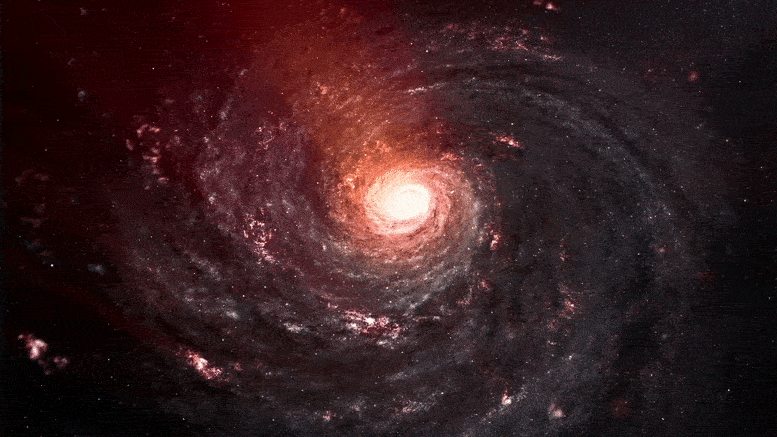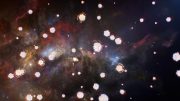
Scientists are utilizing the cosmic microwave background, remnants of the Big Bang, as a 14-billion-year-old backlit screen to locate material around galaxies.
Using light from the Big Bang, an international team led by Cornell and the U.S. Department of Energy’s Lawrence Berkeley National Laboratory has begun to unveil the material which fuels galaxy formation.
“There is uncertainty on the formation of stars within galaxies that theoretical models are unable to predict,” said lead author Stefania Amodeo, a Cornell postdoctoral researcher in astronomy in the College of Arts and Sciences (A&S), who now conducts research at the Observatory of Strasbourg, France. “With this work, we are providing tests for galaxy formation models to comprehend galaxy and star formation.”
The research, “Atacama Cosmology Telescope: Modeling the Gas Thermodynamics in BOSS CMASS galaxies from Kinematic and Thermal Sunyaev-Zel’dovich Measurements,” appears in the March 15, 2021, edition of Physical Review D.
Proto galaxies are always full of gas and when they cool, the galaxies start to form, said senior author Nick Battaglia, assistant professor of astronomy in A&S. “If we were to just do a back-of-the-envelope calculation, gas should turn into stars,” he said. “But it doesn’t.”
Galaxies are inefficient when they manufacture stars, Battaglia said. “About 10% of the gas – at most – in any given galaxy gets turned into stars,” he explained, “and we want to know why.”
The scientists can now check their longtime theoretical work and simulations, by looking at microwave observations with data and applying a 1970s-era mathematical equation. They’ve looked at data from Atacama Cosmology Telescope (ACT) – which observes the Big Bang’s static-filled cosmic microwave background (CMB) radiation – and search for the Sunyaev-Zel’dovich effects. That combination of data enables the scientists to map out the material around that indicate the formation of galaxies in various stages.
“How do galaxies form and evolve in our universe?” Battaglia said. “Given the nature of astronomy, we can’t sit and watch a galaxy evolve. We use various telescopic snapshots of galaxies – and each has its own evolution – and we try and stitch that information together. From there, we can extrapolate Milky Way formation.”
Effectively, the scientists are using the cosmic microwave background – remnants of the Big Bang – as a backlit screen that is 14 billion years old to find this material around galaxies.
“It’s like a watermark on a banknote,” said co-author Emmanuel Schaan, the Chamberlain postdoctoral fellow at the Lawrence Berkeley National Laboratory. “If you put it in front of a backlight then the watermark appears as a shadow. For us, the backlight is the cosmic microwave background. It serves to illuminate the gas from behind, so we can see the shadow as the CMB light travels through that gas.”
Together with Simone Ferraro, divisional fellow at Lawrence Berkeley, Schaan led the measurement part of the project.
“We’re making these measurements of this galactic material at distances from galaxy centers never before done,” Battaglia said. “These new observations are pushing the field.”
Reference: “Atacama Cosmology Telescope: Modeling the gas thermodynamics in BOSS CMASS galaxies from kinematic and thermal Sunyaev-Zel’dovich measurements” by
Stefania Amodeo et al., 15 March 2021, Physical Review D.
DOI: 10.1103/PhysRevD.103.063514
In addition to Battaglia, Amodeo, Cornell researchers include doctoral students Emily Moser, Victoria Calafut, Eve Vavagiakis; Steve K. Choi, National Science Foundation postdoctoral fellow at the Cornell Center for Astrophysics and Planetary Astronomy; Rachel Bean, professor of astronomy and senior associate dean in A&S; and Mike Niemack, associate professor of physics and astronomy in A&S.
The ACT team is an international collaboration, with scientists from 41 institutions in seven countries.
In addition to the National Science Foundation’s Atacama Cosmology Telescope, the work was supported by the Baryon Oscillation Spectroscopic Survey in New Mexico, where the Berkeley Lab played a leading role; the European Space Agency’s Planck telescope and the Herschel Space Telescope; and the Cori supercomputer at Berkeley Lab’s National Energy Research Scientific Computing Center.
A National Science Foundation Astronomy and Astrophysics research grant funded the research.









Quark black holes of galaxies are synthesized in the string black hole of the center of our universe. The black holes of galaxies synthesize all the stars, and the stars synthesize their planetary systems. Moreover, if the stars give birth to planets in one spiral arm, Black holes give birth to stars in 2 – 10 arms, then the center of our universe can synthesize black holes of galaxies, possibly in 100 arms.
https://www.youtube.com/watch?v=tFUM3vAlaGc
Black holes are, as far as we know, only of one type and they don’t tell of what matter they contain [ https://en.wikipedia.org/wiki/No-hair_theorem ].
That link is self-promoting a youtube channel, and since you don’t give any references here for your extraordinary claims it is most likely pseudoscience. “That which can be asserted without evidence, can be dismissed without evidence.”
“Galaxies are inefficient when they manufacture stars, Battaglia said. “About 10% of the gas – at most – in any given galaxy gets turned into stars,” he explained, “and we want to know why.””
Already noted as the new research edge in a 2018 outline:
“Perhaps the simulations’ single biggest lesson so far is not that scientists need to revise their overarching theory of cosmology, but rather that problems lurk in their understanding of astrophysics at smaller scales. In particular, their theory of star formation comes up wanting, Springel says. To produce realistic galaxies, modelers must drastically reduce the rate at which clouds of gas form stars from what astrophysicists expect, he says. “Basically, the molecular clouds form stars 100 times slower than you’d think,” he says.”
[“Galaxy simulations are at last matching reality—and producing surprising insights into cosmic evolution”, Science]
So here they estimate an order of magnitude less remaining discrepancy.
There are ongoing studies that suggest some solutions. Here is one I know of:
“The study leaves astronomers still wondering why star formation is so inefficient. Only 30% of a hydrogen gas cloud’s initial mass winds up as a newborn star.”
[ https://scitechdaily.com/astronomers-puzzled-after-hubble-view-of-torrential-outflows-from-infant-stars-blows-hole-in-current-theories/ ]
From the paper:
“Measurements of the molecular gas with millimeter interferometry are needed to determine whether slower, higher density flows entrained by the outflows are responsible for the halting of infall/accretion and the ∼ 30–40 % star formation efficiencies. If they are not, mechanisms other than feedback may be required.”
If they are not, mechanisms other than feedback may be required.”
________________________________________________________________________
Black holes are, as far as we know, only of one type
_______________________________________________________
I suggest other mechanisms. I have gone far ahead and know 3 types of black holes:
1) string – is in the center of our universe;
2) quark – are in the centers of galaxies;
3) nucleon – are under the crown of stars.
From dust and gas stars and planets are not born. If dust and gas clouds also disappear, only because they settle on the planet born of stars.
You can have your own opinion, but you can’t have your own facts.
Science knows only one type of black hole, so you do too (at best).